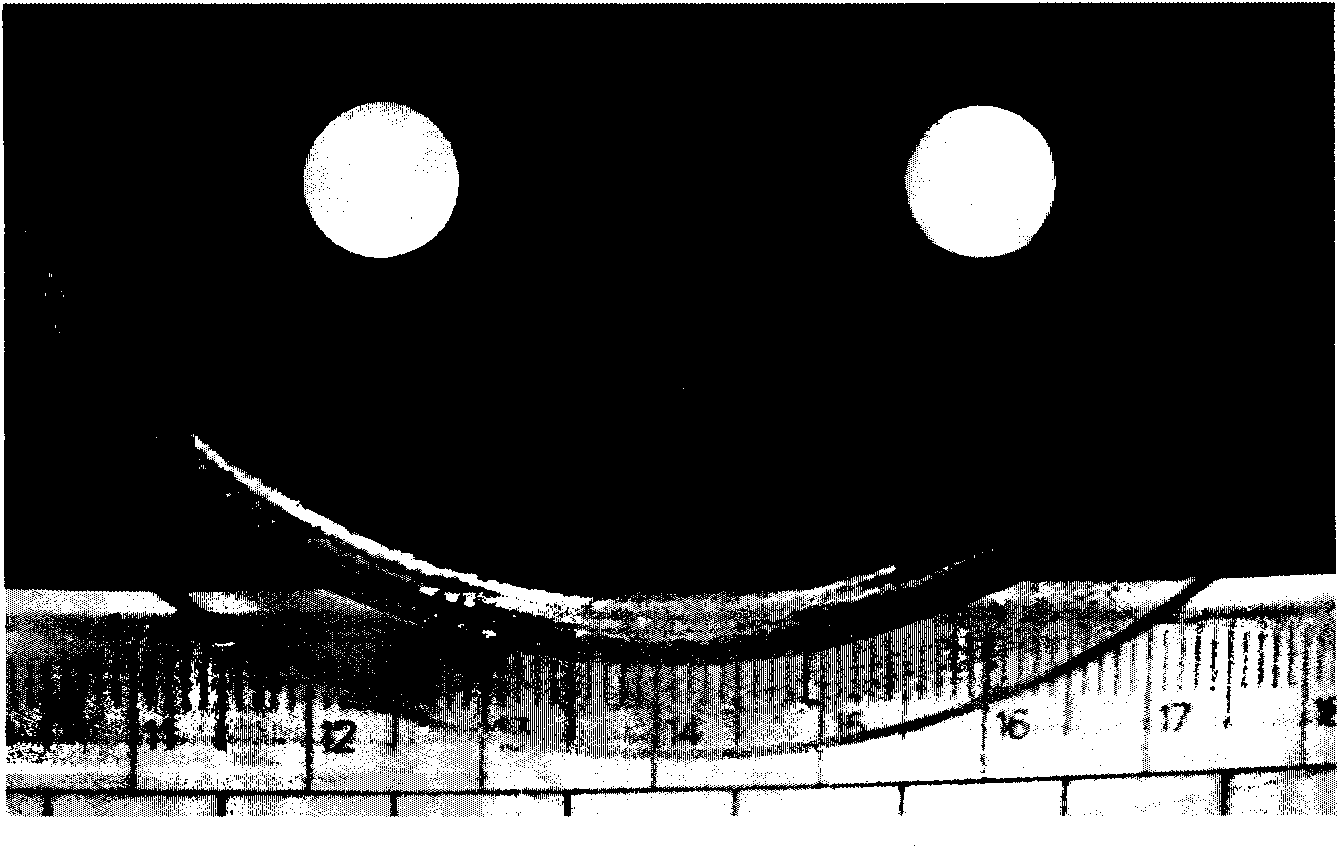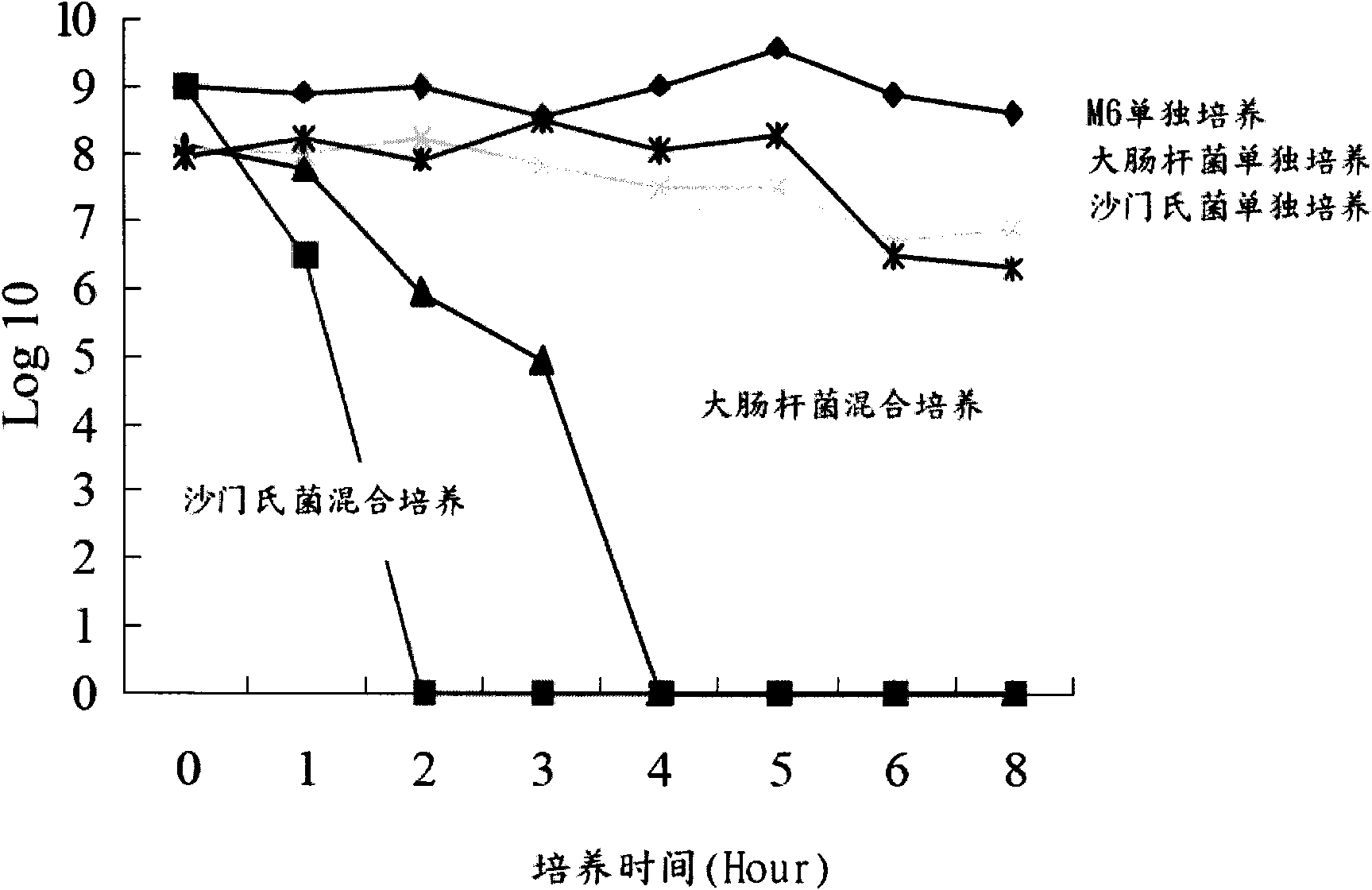Lactobacillus salivarius M6 and antibacterial composition containing same
A technology of Lactobacillus salivarius and composition, applied in the direction of medical preparations containing active ingredients, bacteria, microorganisms, etc., can solve problems such as unfavorable health, weakened intestinal function, diarrhea, dehydration, etc., to increase ability and improve intestinal tract The number of probiotics and the effect of inhibiting the growth of pathogenic bacteria
- Summary
- Abstract
- Description
- Claims
- Application Information
AI Technical Summary
Problems solved by technology
Method used
Image
Examples
Embodiment 1
[0033] Example 1 Inhibition of Escherichia coli and Salmonella by Lactobacillus salivarius
[0034] 1. Filter paper agar diffusion method
[0035]Lactobacillus salivarius M6 was screened from the intestinal tract of animals, and its culture characteristics are as follows: gray colonies with a diameter of 2-3 mm grow on MRS (Difco, REF288130) agar plates, and the optimum culture temperature is 37°C.
[0036] Take a colony of Escherichia coli (BCRC 11634) and Salmonella (BCRC12947) of Platinum ear and inoculate it on the slant of TSA medium (Soybean-Casein Digest Agar Medium, DifcoTM, REF236950), cultivate it at 35-37°C for 17-24 hours, and use spectroscopic The turbidity measurement is carried out with a photometer, and the appropriate turbidity of the bacteria is adjusted (80% of the turbidity at about 600 nm, 80% T). Absorb 0.5mL of Escherichia coli and Salmonella bacterial solution into TSA medium at 48°C and mix evenly, then quantitatively pour 15mL into the petri dish, le...
Embodiment 2
[0046] Embodiment 2 animal test
[0047] 1. Effect of Lactobacillus salivarius M6 on growth performance of nursery pigs
[0048] 36 weaned pigs (weaned age: 25 days) were randomly assigned according to sex to the control group, antibiotic group or Lactobacillus salivarius M6 group, with 12 pigs in each group. The main ingredients of the feed were corn and soybean flour. The diet of the control group did not contain carbadox and Lactobacillus salivarius M6, the feed of the antibiotic group was supplemented with carbadox, and the feed of the Lactobacillus salivarius M6 group was supplemented with Lactobacillus salivarius M6. During the test period, free food and free drinking water were adopted, and the test was carried out for 28 days to compare the growth performance of piglets, the number of bacteria and diarrhea. Each pig was weighed at the beginning and end of the experiment, and the feed intake of each group was recorded to calculate the daily gain and feed conversion rat...
Embodiment 3
[0055] Example 3 Lactobacillus salivarius M6 and other lactic acid bacteria are compared for the tolerance of commonly used animal antibiotics
[0056] The antibiotic susceptibility test was used to analyze and compare the tolerance of Lactobacillus salivarius M6 and other lactic acid bacteria to antibiotics. The smaller the inhibition zone, the better the tolerance of this lactic acid bacteria to antibiotics. After Lactobacillus salivarius M6 and other lactic acid bacteria were cultured with MRS based on anaerobic culture at 37°C, 100 μL of each was evenly spread on the MRS agar. After standing still for 20-30 minutes, place a 6mm sterile filter paper, add 5 μL of three antibiotics commonly used in animal feed, place it in anaerobic culture at 35-37°C for 16-24 hours, and measure the size of the inhibition zone (mm ), and the measurement results are shown in Table 3. When the concentration of aureomycin is 10μg / Disc or 30μg / Disc, Lactobacillus salivarius M6 has the smallest ...
PUM
| Property | Measurement | Unit |
|---|---|---|
| diameter | aaaaa | aaaaa |
Abstract
Description
Claims
Application Information
 Login to View More
Login to View More - R&D
- Intellectual Property
- Life Sciences
- Materials
- Tech Scout
- Unparalleled Data Quality
- Higher Quality Content
- 60% Fewer Hallucinations
Browse by: Latest US Patents, China's latest patents, Technical Efficacy Thesaurus, Application Domain, Technology Topic, Popular Technical Reports.
© 2025 PatSnap. All rights reserved.Legal|Privacy policy|Modern Slavery Act Transparency Statement|Sitemap|About US| Contact US: help@patsnap.com



